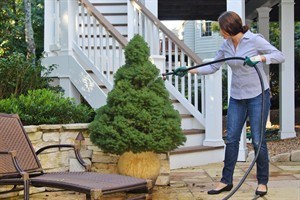
In this 2012 publicity photo provided by PLANET, a woman waters her plants at a private residence in Dunn Loring, Va. Place plants in the right location for sun or shade. Doing so will create less stress on the plants, which will help to keep them disease-free and less stressed under low water conditions. (AP Photo/PLANET, National Landscape Industry Association, Philippe Nobile)
June 19, 2013 - 6:21 AM
Smart irrigation is becoming a hot landscaping specialty as groundwater aquifers are increasingly sucked dry.
Thirsty lawns, energy production, and expanding "wet" industries like hydraulic fracture mining and farm irrigation are vying for water resources, leading to tougher watering restrictions and higher prices.
"The EPA is moving from encouragement to enforcement on the municipal, commercial level," said Jeff Gibson, landscape business manager for Ball Horticultural Co. in West Chicago, Ill. "Many new municipal ordinances in the country dictate the types of 'heads' (low pressure, low volume sprinklers, typically) that may be used with new installations."
Numerous states and some municipalities also are starting to offer tax incentives for installing low-water-use irrigation systems, Gibson said.
Water shortages already impact every continent, according to the United Nations Department of Economic and Social Affairs. "Around 1.2 billion people, or almost one-fifth of the world's population, live in areas of physical scarcity, and 500 million people are approaching this situation."
Depleted water supplies are both a natural and human-made phenomenon, the agency says. "There is enough freshwater on the planet for six billion people but it is distributed unevenly and too much of it is wasted, polluted or unsustainably managed."
Planet, the national landscape industry association, lists five strategies for smarter watering:
— Making your soil healthier. Break up and amend the soil 12 to 18 inches deep so plant roots can penetrate deeper. "The most important thing in landscaping is soil preparation and choosing plants suited to the micro-climate where they're going," said Kurt Bland, a Planet spokesman and president of Bland Landscaping Co. in Apex, N.C.
— Grouping plants with similar water needs together. "Doing so will create less stress on the plants, which will help keep them disease-free under low water conditions," the trade association says.
— Choosing the right grasses for lawns. "Turf grass is incredibly resilient and genetically geared to go dormant in drought conditions," a Planet handout says. "Ask a professional for what drought tolerant species will do well in your lawn based on sun exposure and soil type."
— Creating an irrigation plan that includes reclaimed water and low-consumption drip systems. "Drip irrigation, while saving water, can increase vegetable yields and plant growth," said Robert Kourik, author of "Drip Irrigation for Every Landscape and All Climates" (Metamorphic Press, 2009.) "The improper use of irrigation creates a too-wet and too-dry cycle. This adds more stress to the roots and less-than-ideal growth. Drip irrigation promotes the best growth possible."
— Mulching, which retains moisture, smothers weeds and adds nutrients to the soil.
"Water rates as they increase are getting people's attention," Bland said. "Ordinances requiring monitors limiting how much water can be used also seem to be working."
___
Online:
Planet fact sheet: http://www.loveyourlandscape.com/sustainability/watersavingtips.cfm
You can contact Dean Fosdick at deanfosdick@netscape.net
News from © The Associated Press, 2013